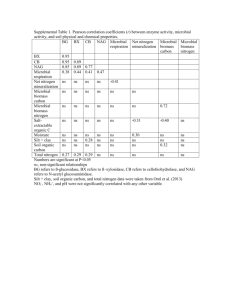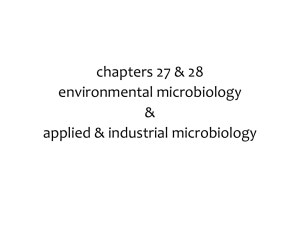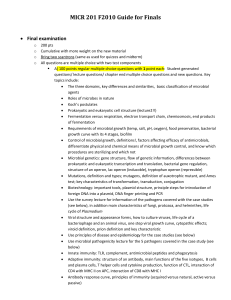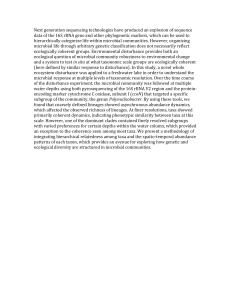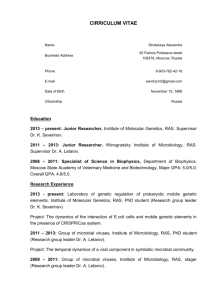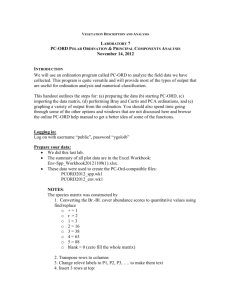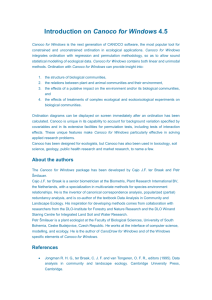Additional file 13
advertisement
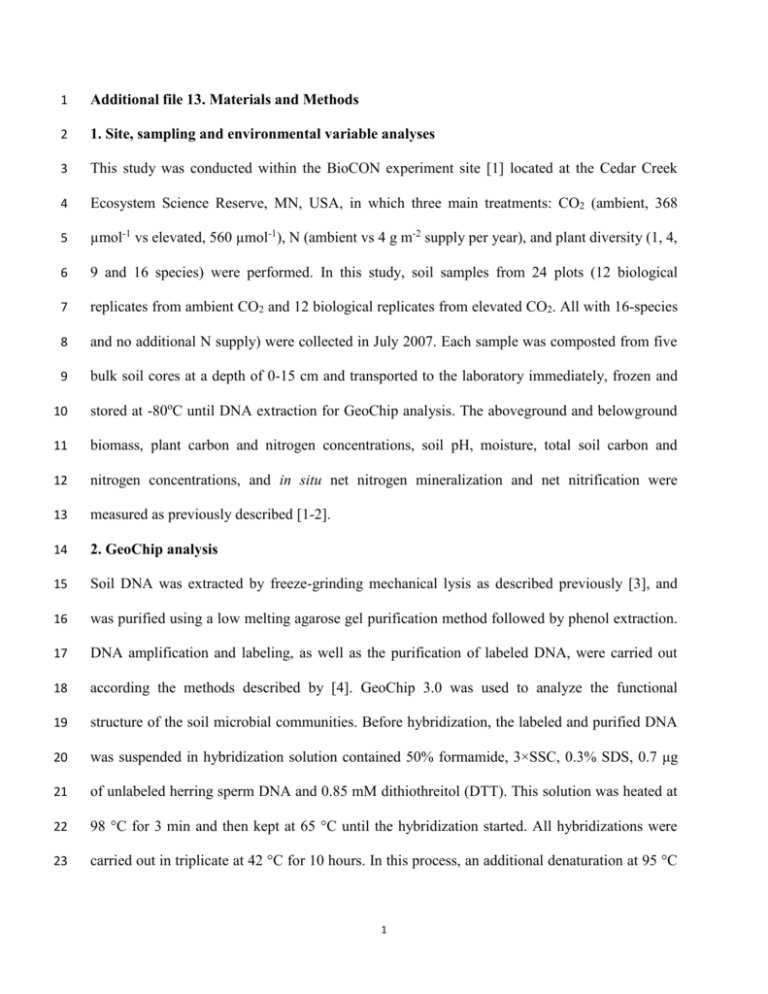
1 Additional file 13. Materials and Methods 2 1. Site, sampling and environmental variable analyses 3 This study was conducted within the BioCON experiment site [1] located at the Cedar Creek 4 Ecosystem Science Reserve, MN, USA, in which three main treatments: CO2 (ambient, 368 5 µmol-1 vs elevated, 560 µmol-1), N (ambient vs 4 g m-2 supply per year), and plant diversity (1, 4, 6 9 and 16 species) were performed. In this study, soil samples from 24 plots (12 biological 7 replicates from ambient CO2 and 12 biological replicates from elevated CO2. All with 16-species 8 and no additional N supply) were collected in July 2007. Each sample was composted from five 9 bulk soil cores at a depth of 0-15 cm and transported to the laboratory immediately, frozen and 10 stored at -80oC until DNA extraction for GeoChip analysis. The aboveground and belowground 11 biomass, plant carbon and nitrogen concentrations, soil pH, moisture, total soil carbon and 12 nitrogen concentrations, and in situ net nitrogen mineralization and net nitrification were 13 measured as previously described [1-2]. 14 2. GeoChip analysis 15 Soil DNA was extracted by freeze-grinding mechanical lysis as described previously [3], and 16 was purified using a low melting agarose gel purification method followed by phenol extraction. 17 DNA amplification and labeling, as well as the purification of labeled DNA, were carried out 18 according the methods described by [4]. GeoChip 3.0 was used to analyze the functional 19 structure of the soil microbial communities. Before hybridization, the labeled and purified DNA 20 was suspended in hybridization solution contained 50% formamide, 3×SSC, 0.3% SDS, 0.7 μg 21 of unlabeled herring sperm DNA and 0.85 mM dithiothreitol (DTT). This solution was heated at 22 98 °C for 3 min and then kept at 65 °C until the hybridization started. All hybridizations were 23 carried out in triplicate at 42 °C for 10 hours. In this process, an additional denaturation at 95 °C 1 24 for 1 min with agitation was performed after a 45-min prehybridization. 25 washes processes, one-time wash at 23 °C for 20 sec with wash buffer II (0.1×SSC, 0.1% SDS) 26 was added before three-time washes at 23 °C for 10 sec with wash buffer III (0.1×SSC). After 27 washing and drying, the arrays were scanned by ScanArray Express Microarray Scanner (Perkin 28 Elmer, Boston, MA) at 633 nm using a laser power of 90% and a photomultiplier tube (PMT) 29 gain of 75%. ImaGene version 6.0 (Biodiscovery, El Segundo, CA) was then used to determine 30 fluorescence image intensity and background intensity, as well as to identify spots of poor 31 quality. Raw data from ImaGene were submitted to Microarray Data Manager in our website 32 (http://ieg.ou.edu/microarray/) and analyzed using data analysis pipeline with the following 33 major steps: (i) The spots flagged as 1 or 3 by Imagene and with a signal to noise ratio (SNR) 34 less than 2.0 were removed as poor- quality spots. 35 intensity of each spot was calculated by dividing the signal intensity of each spot by the mean 36 intensity of the sample. For outlier removal, if any of replicates had (signal–mean) more than 37 two times the standard deviation, this replicate was moved. This process continued until no such 38 replicates were identified. Finally, at least 0.34 time of the final positive spot (probe) number 39 (minimum of two spots) was required for a particular gene. 40 3. Statistical analysis 41 The matrices of microarray data resulting from our pipeline were considered as ‘species’ 42 abundance in statistical analyses. The dataset containing the functional genes shared by at least 43 three samples in the biological replicate was applied to do further analysis. Direct and indirect 44 multivariate ordination analyses were carried using PC-ORD for Windows [5] and confirmed by 45 CANOCO 4.5 for Windows (Biometris – Plant Research International, The Netherlands). 46 Detrended correspondence analysis (DCA) [6] , combined with analysis of similarities 2 In past hybridization After bad spot’s cleaning, normalized 47 (ANOSIM), non-parametric multivariate analysis of variance (Adonis) and Multi-Response 48 Permutation Procedure (MRPP), was used to determine the overall functional changes in the 49 microbial communities. To eliminate the potential bias caused by filling, normalized intensities 50 with filling small values or binary data for gene present or absent were used to do the statistical 51 analyses. The effects of elevated CO2 on functional microbial communities, microbial processes, 52 and environmental parameters were analyzed by computing the response ratio (RR) using the 53 formula described by Luo et al. [7]. The total abundance of each gene category or family was 54 simply the sum of the normalized intensity for the gene category or family. For comparing the 55 relative abundances of different organisms, the total abundance values were calculated by 56 summing the normalized intensity of the genes detected for this organism. 57 Redundancy analysis (RDA) was carried to reveal the individual or a set of environmental 58 variables significantly explained the variation in functional microbial communities using 59 CANOCO 4.5 for Windows (Biometris – Plant Research International, The Netherlands). 60 Meanwhile, RDA with forward selection and unrestricted Monte Carlo permutation test based on 61 999 random permutations of the residuals under the full regression model were used to select the 62 minimum number of environmental variables explaining the largest amount of variation in the 63 model. The relative contribution of individual environmental variables to the ordination axes was 64 evaluated by canonical coefficients (significance of approximate t-tests) and intraset correlations. 65 Unrestricted Monte Carlo permutation tests (999 permutations, p≤0.05) were used to test the 66 statistical significance of the first 2 ordination axes. In order to evaluate the specific contribution 67 of each significant variable, a variation partitioning analysis was run with the variables of 68 interest as explanatory variables and the other significant variables as covariables [8-9]. 69 Correlations between the matrixes were calculated and tested for significance (p-value) using 3 70 Mantel test in PC-ORD for Windows. Significant Pearson’s linear correlation (r) analysis, and 71 analyses of variance (ANOVA) were carried out in SPSS 16.0 for windows (SPSS Inc., Illinois, 72 USA). 73 References: 74 1. Reich PB, Knops J, Tilman D, Craine J, Ellsworth D, Tjoelker M, Lee T, Wedin D, 75 Naeem S, Bahauddin D et al: Plant diversity enhances ecosystem responses to 76 elevated CO2 and nitrogen deposition. Nature 2001, 410(6830):809-812. 77 2. Reich PB, Hobbie SE, Lee T, Ellsworth DS, West JB, Tilman D, Knops JMH, Naeem S, 78 Trost J: Nitrogen limitation constrains sustainability of ecosystem response to CO2. 79 Nature 2006, 440(7086):922-925. 80 3. 81 82 Zhou J, Bruns MA, Tiedje JM: DNA recovery from soils of diverse composition. Appl Environ Microbiol 1996, 62(2):316-322. 4. Xu M, Wu WM, Wu L, He Z, Van Nostrand JD, Deng Y, Luo J, Carley J, Ginder-Vogel 83 M, Gentry TJ et al: Responses of microbial community functional structures to 84 pilot-scale uranium in situ bioremediation. ISME J 2010, 4(8):1060-1070. 85 5. User’s guide. MjM Software Design, Gleneden Beach, Oregon. 1999. 86 87 6. 88 89 7. Luo Y, Hui D, Zhang D: Elevated CO2 stimulates net accumulations of carbon and nitrogen in land ecosystems: a meta-analysis. Ecology 2006, 87(1):53-63. 8. 92 93 Hill MO, Gauch HG: Deterended correspondence analysis, an improved ordination technique. Vegetatio 1980, 42(47-58). 90 91 McCune B, Mefford MJ: PC-ORD: multivariate analysis of ecological data. Version 4. Ramette A: Multivariate analyses in microbial ecology. Fems Microbiology Ecology 2007, 62(2):142-160. 9. Ramette A, Tiedje JM: Multiscale responses of microbial life to spatial distance and 94 environmental heterogeneity in a patchy ecosystem. Proceedings of the National 95 Academy of Sciences 2007, 104(8):2761-2766. 96 97 4
